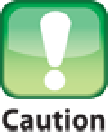Information Technology Reference
In-Depth Information
If you can't boot MacBook Air, you can't access the Recovery HD, and you don't have either a Recovery disk
or the OS X Install flash drive, you might think you're out of luck. Not yet! If you have access to a second Mac
that supports Thunderbolt, your last option is to restart MacBook Air in target disk mode. Here's how:
1. Connect MacBook Air and the other Mac using a Thunderbolt cable.
2. Restart MacBook Air.
3. During the restart, hold down T until you see the Thunderbolt icon.
MacBook Air is now in target
disk mode.
4. Restart the other Mac.
5. When the other Mac's desktop appears, the MacBook Air's hard drive appears as a drive on the
other Mac.
This enables you to use Disk Utility on the other Mac to verify or repair the MacBook Air hard
drive.
Repairing the hard drive
If MacBook Air won't start, or if an application freezes, it's possible that an error on the hard drive is causing
the problem. To see if this is the case, you need to repair the hard drive using MacBook Air's Disk Utility pro-
gram. How are you supposed to do that if you can't even start MacBook Air? Good question! The answer is that
you need to restart MacBook Air using a secondary boot device: the Recovery HD, an external Recovery disk,
the OS X Install flash drive, or in target disk mode using another Mac (see the previous three sections for the
details). You then run Disk Utility from the secondary boot device, which enables you to repair your main hard
drive. Note, too, that even if you can start MacBook Air, you still need to boot to the secondary device because
you can't repair the main hard drive while it's being used by MacBook Air.
Because repairing your hard drive can occasionally cause problems, be sure to back it up before attempting the repair
(assuming you can access OS X).
Follow these steps to repair your hard drive:
1. Restart MacBook Air using a secondary boot device.
2. Launch Disk Utility.
Use one of the following procedures, depending on which device you boot to:
•
OS X Mountain Lion Recovery HD partition.
Click Disk Utility and then click Continue.
•
Mac in target disk mode.
Open Launchpad on the other Mac and choose Other →Disk Utility.
•
OS X Install flash drive.
When you get to the OS X Installer screen, choose Utilities →Disk Utility.
3. Choose Macintosh HD, which is the hard drive you want to repair.
If MacBook Air is in target disk
mode, be sure to click the Macintosh HD that appears under the AAPL Thunderbolt Target Media disk.
4. Make sure the First Aid tab is selected, as shown in Figure 11.8.
5. Click Repair Disk.
Disk Utility verifies that the drive is sound and fixes any problems that it finds.

